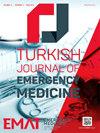流口水,不情愿,口咽,其他,和白细胞计数的诊断准确性预测死亡率和急性腐蚀性食入并发症
IF 2.3
Q3 EMERGENCY MEDICINE
引用次数: 0
摘要
本文章由计算机程序翻译,如有差异,请以英文原文为准。
Diagnostic accuracy of drooling, reluctance, oropharynx, others, and leukocytosis score as a predictor of mortality and complications following acute corrosive ingestion
OBJECTIVES: Esophagogastroduodenoscopy is considered the gold standard in assessing the severity of injury to the gastrointestinal tract following corrosive ingestion. Zargar’s endoscopic grading of injury helps in prognostication as well as guiding management. Since the major burden of cases lies in resource-limited settings, the availability of endoscopic evaluation is a limiting factor. Hence, it is prudent to develop bedside tools that can be used as screening tools to identify patients at high risk of mortality and complications so that timely referrals and judicious utilization of resources can be made. Literature in this regard is limited and published studies have shown that clinical features fail to predict the severity of injury. We aimed our study to find the role of Drooling, Reluctance, Oropharynx, Others, and Leukocytosis (DROOL) score as a predictor of mortality and complications following acute corrosive ingestion. METHODS: This was a diagnostic accuracy study conducted in the emergency department (ED) of a tertiary care hospital in North India. We screened all cases of acute corrosive ingestion presented to our ED. We collected the data on demographic profile, clinical features, investigations, endoscopy findings, treatment, and DROOL score. We followed patients for up to 12 weeks for outcomes including mortality and complications. RESULTS: We studied 79 patients of acute corrosive ingestion. The median age was 26 years with a female predominance. Nausea, vomiting, and pain abdomen were the common symptoms. The median DROOL score was 4. The majority of our patients had normal to Zargar grade 1 injury to the stomach and esophagus. Out of 79 patients, 27 patients developed some complications. The overall mortality up to 12 weeks was 10%. The receiver operating characteristics (ROC) analysis was performed, and the area under the ROC (AUROC) curve of Zargar classification in predicting overall complications was 0.909 (96% confidence interval [CI]: 0.842–0.975) and it was 0.775 (95% CI: 0.553–1.000) in predicting mortality. The AUROC of DROOL score in predicting overall complications was 0.932 (95% CI: 0.877–0.987) and the AUROC of DROOL score in predicting mortality was 0.864 (95% CI: 0.758–0.970). The ROC analysis showed that a DROOL score ≤4 has a sensitivity of 96.2% and a specificity of 77.8% in predicting overall complications. Similarly, DROOL score ≤5 has a sensitivity of 81.7% and a specificity of 62.5% in predicting the development of mortality. Delong test showed that there was no statistically significant difference in Zargar versus DROOL score in terms of prediction of mortality and overall complications (P > 0.05). CONCLUSION: DROOL score is comparable to Zargar score in identifying patients at high risk of mortality and complications. Hence, DROOL score can be used for risk stratification of patients presenting with corrosive ingestion.
求助全文
通过发布文献求助,成功后即可免费获取论文全文。
去求助
来源期刊

Turkish Journal of Emergency Medicine
EMERGENCY MEDICINE-
CiteScore
1.70
自引率
0.00%
发文量
30
审稿时长
22 weeks
期刊介绍:
The Turkish Journal of Emergency Medicine (Turk J Emerg Med) is an International, peer-reviewed, open-access journal that publishes clinical and experimental trials, case reports, invited reviews, case images, letters to the Editor, and interesting research conducted in all fields of Emergency Medicine. The Journal is the official scientific publication of the Emergency Medicine Association of Turkey (EMAT) and is printed four times a year, in January, April, July and October. The language of the journal is English. The Journal is based on independent and unbiased double-blinded peer-reviewed principles. Only unpublished papers that are not under review for publication elsewhere can be submitted. The authors are responsible for the scientific content of the material to be published. The Turkish Journal of Emergency Medicine reserves the right to request any research materials on which the paper is based. The Editorial Board of the Turkish Journal of Emergency Medicine and the Publisher adheres to the principles of the International Council of Medical Journal Editors, the World Association of Medical Editors, the Council of Science Editors, the Committee on Publication Ethics, the US National Library of Medicine, the US Office of Research Integrity, the European Association of Science Editors, and the International Society of Managing and Technical Editors.
 求助内容:
求助内容: 应助结果提醒方式:
应助结果提醒方式:


